Machine Learning Based on Computed Tomography Pulmonary Angiography in Evaluating Pulmonary Artery Pressure in Patients with Pulmonary Hypertension
Abstract
:1. Introduction
2. Materials and Methods
2.1. Patients
2.2. Imaging Protocol
2.3. Right-Heart Catheterization
2.4. Segmentation Ground-Truth Definition
2.4.1. Data Standardization and the Localization of Heart and Pulmonary Artery
2.4.2. Contours of Eight Substructure Delineation
2.5. Image Segmentation
2.6. Features Extraction and Selection
2.6.1. The Extraction of Morphological and Second-Order Features
2.6.2. Feature Selection and Dimension Reduction
2.7. Regression and Classification Model Construction
2.8. Statistics Analysis
3. Results
3.1. Study Population Characteristics
3.2. Computational Time
3.3. The Performance of the Segmentation Framework
3.4. Comparison of Manual Measurement and AI Automatic Measurement
3.5. The Correlations between Pulmonary Artery Pressure and Selected Features
3.6. The Performance of the Regression Model
3.7. The Performance of the Classification Model
4. Discussion
5. Conclusions
Author Contributions
Funding
Institutional Review Board Statement
Informed Consent Statement
Data Availability Statement
Conflicts of Interest
Abbreviations
| AUC | area under the receiver operating characteristic curve |
| CTPA | computed tomography pulmonary angiography |
| dPAP | pulmonary artery diastolic pressure |
| ICC | intraclass correlation coefficient |
| mPAP | mean pulmonary artery pressure |
| MSE | mean square error |
| PH | pulmonary hypertension |
| RHC | right heart catheterization |
| sPAP | pulmonary artery systolic pressure |
| TPR | total pulmonary resistance |
References
- Hassoun, P.M. Pulmonary Arterial Hypertension. N. Engl. J. Med. 2021, 385, 2361–2376. [Google Scholar] [CrossRef] [PubMed]
- Humbert, M.; Sitbon, O.; Chaouat, A.; Bertocchi, M.; Habib, G.; Gressin, V.; Yaici, A.; Weitzenblum, E.; Cordier, J.F.; Chabot, F.; et al. Pulmonary arterial hypertension in France: Results from a national registry. Am. J. Respir. Crit. Care Med. 2006, 173, 1023–1030. [Google Scholar] [CrossRef] [PubMed]
- Thenappan, T.; Mark, L.; John, J.R.; Stephen, L.A. Pulmonary arterial hypertension: Pathogenesis and clinical management. BMJ 2018, 360, j5492. [Google Scholar] [CrossRef] [PubMed]
- Darlene, K.M.; Patricia, G. Pulmonary Hypertension. Med. Clin. North Am. 2019, 103, 413–423. [Google Scholar]
- Hansmann, G. Pulmonary hypertension in infants, children, and young adults. J. Am. Coll. Cardiol. 2017, 69, 2551–2569. [Google Scholar] [CrossRef]
- Hoeper, M.M.; Lee, S.H.; Voswinckel, R.; Palazzini, M.; Jais, X.; Marinelli, A.; Barst, R.J.; Ghofrani, H.A.; Jing, Z.C.; Opitz, C.; et al. Complications of right heart catheterization procedures in patients with pulmonary hypertension in experienced centers. J. Am. Coll. Cardiol. 2006, 48, 2546–2552. [Google Scholar] [CrossRef]
- Zhai, Z.; Ota, H.; Staring, M.; Stolk, J.; Sugimura, K.; Takase, K.; Stoel, B.C. Treatment effect of balloon pulmonary angioplasty in chronic thromboembolic pulmonary hypertension quantified by automatic comparative imaging in computed tomography pulmonary angiography. Investig. Radiol. 2018, 53, 286–292. [Google Scholar] [CrossRef]
- Vizza, C.D.; Hoeper, M.M.; Huscher, D.; Pittrow, D.; Benjamin, N.; Olsson, K.M.; Ghofrani, H.A.; Held, M.; Klose, H.; Lange, T.; et al. Pulmonary hypertension in patients with COPD: Results from the comparative, prospective registry of newly initiated therapies for pulmonary hypertension (COMPERA). Chest 2021, 160, 678–689. [Google Scholar] [CrossRef]
- Simonneau, G.; Montani, D.; Celermajer, D.S.; Denton, C.P.; Gatzoulis, M.A.; Krowka, M.; Williams, P.G.; Souza, R. Haemodynamic definitions and updated clinical classification of pulmonary hypertension. Eur. Respir. J. 2019, 53, 1801913. [Google Scholar] [CrossRef]
- Chaouat, A.; Bugnet, A.S.; Kadaoui, N.; Schott, R.; Enache, I.; Ducolone, A.; Ehrhart, M.; Kessler, R.; Weitzenblum, E. Severe pulmonary hypertension and chronic obstructive pulmonary disease. Am. J. Respir Crit. Care Med. 2005, 172, 189–194. [Google Scholar] [CrossRef]
- Nadrous, H.F.; Pellikka, P.A.; Krowka, M.J.; Swanson, K.L.; Chaowalit, N.; Decker, P.A.; Ryu, J.H. The impact of pulmonary hypertension on survival in patients with idiopathic pulmonary fibrosis. Chest 2005, 128, 616S–617S. [Google Scholar] [CrossRef] [PubMed]
- Coisne, A.; Aghezzaf, S.; Galli, E.; Mouton, S.; Richardon, M.; Dubois, D.; Delsart, P.; Domanski, O.; Bauters, C.; Charton, M.; et al. Prognostic values of exercise echocardiography and cardiopulmonary exercise testing in patients with primary mitral regurgitation. Eur. Heart J. Cardiovasc. Imaging 2022, 23, 1552–1561. [Google Scholar] [CrossRef] [PubMed]
- Arangalage, D.; Cattan, L.; Eugène, M.; Cimadevilla, C.; Monney, P.; Lung, B.; Brichet, E.; Burwash, I.G.; Vahanian, A.; Messika-Zeioun, D.M. Prognostic value of peak exercise systolic pulmonary arterial pressure in asymptomatic primary mitral valve regurgitation. J. Am. Soc. Echocardiogr. 2021, 34, 932–940. [Google Scholar] [CrossRef] [PubMed]
- Liu, M.; Ma, Z.; Guo, X.; Zhang, H.; Yang, Y.; Wang, C. Computed tomographic pulmonary angiography in the assessment of severity of chronic thromboembolic pulmonary hypertension and right ventricular dysfunction. Eur. J. Radiol. 2011, 80, e462–e469. [Google Scholar] [CrossRef]
- Liu, M.; Ma, Z.; Guo, X.; Chen, X.; Yang, Y.; Wang, C. Cardiovascular parameters of computed tomographic pulmonary angiography to assess pulmonary vascular resistance in patients with chronic thromboembolic pulmonary hypertension. Int. J. Cardiol. 2013, 164, 295–300. [Google Scholar] [CrossRef]
- Melzig, C.; Wörz, S.; Egenlauf, B.; Partovi, S.; Rohr, K.; Grunig, E.; Kauczor, H.U.; Heussel, C.P.; Rengier, F. Combined automated 3D volumetry by pulmonary CT angiography and echocardiography for detection of pulmonary hypertension. Eur. Radiol. 2019, 29, 6059–6068. [Google Scholar] [CrossRef]
- Jia, D.; Zhou, X.; Hou, G. Estimation of right ventricular dysfunction by computed tomography pulmonary angiography: A valuable adjunct for evaluating the severity of acute pulmonary embolism. J. Thromb. Thrombolysis. 2017, 43, 271–278. [Google Scholar] [CrossRef]
- Zhou, F.; Wang, Y.N.; Schoepf, U.J.; Tesche, C.; Tang, C.X.; Zhou, C.S.; Xu, L.; Hou, Y.; Zheng, M.W.; Yan, J.; et al. Diagnostic performance of machine learning based CT-FFR in detecting ischemia in myocardial bridging and concomitant proximal atherosclerotic disease. Can. J. Cardiol. 2019, 35, 1523–1533. [Google Scholar] [CrossRef]
- Galiè, N.; Humbert, M.; Vachiery, J.L.; Gibbs, S.; Lang, I.; Torbicki, A.; Simonneau, G.; Peacock, A.; Noodegraaf, A.V.; Beghetti, M.; et al. 2015 ESC/ERS guidelines for the diagnosis and treatment of pulmonary hypertension: The joint task force for the diagnosis and treatment of pulmonary hypertension of the European Society of Cardiology (ESC) and the European Respiratory Society (ERS): Endorsed by: Association for European Paediatric and Congenital Cardiology (AEPC), International Society for Heart and Lung Transplantation (ISHLT). Eur. Heart J. 2016, 37, 67–119. [Google Scholar]
- Simonneau, G.; Gatzoulis, M.A.; Adatia, I.; Celermajer, D.; Denton, C.; Ghofrani, A.; Gomez Sanchez, M.a.; Kumar, R.K.; Landzerg, M.; Machado, R.F.; et al. Updated Clinical Classification of Pulmonary Hypertension. J. Am. Coll. Cardiol. 2013, 62, D34–D41. [Google Scholar] [CrossRef]
- Wichmann, J.L.; Willemink, M.J.; De Cecco, C.N. Artificial intelligence and machine learning in radiology: Current state and considerations for routine clinical implementation. Investig. Radiol. 2020, 55, 619–627. [Google Scholar] [CrossRef]
- Isensee, F.; Jaeger, P.F.; Kohl, S.A.A.; Petersen, J.; Maier-Hein, K.H. nnU-Net: A self-configuring method for deep learning-based biomedical image segmentation. Nat. Methods. 2021, 18, 203–211. [Google Scholar] [CrossRef]
- Tahmassebi, A.; Wengert, G.J.; Helbich, T.H.; Bago-Horvath, Z.; Alaei, S.; Bartsch, R.; Dubsky, P.; Baltzer, P.; Clauser, P.; Kapetas, P.; et al. Impact of machine learning with multiparametric magnetic resonance imaging of the breast for early prediction of response to neoadjuvant chemotherapy and survival outcomes in breast cancer patients. Investig. Radiol. 2019, 54, 110–117. [Google Scholar] [CrossRef]
- Christe, A.; Peters, A.A.; Drakopoulos, D.; Heverhagen, J.T.; Geiser, T.; Stathopoulou, T.; Christodoulidis, S.; Anthimopoulos, M.; Mougiakakou, S.G.; Ebner, L. Computer-aided diagnosis of pulmonary fibrosis using deep learning and CT images. Investig. Radiol. 2019, 54, 627–632. [Google Scholar] [CrossRef]
- Hagiwara, A.; Fujita, S.; Ohno, Y.; Aoki, S. Variability and standardization of quantitative imaging: Monoparametric to multiparametric quantification, radiomics, and artificial intelligence. Investig. Radiol. 2020, 55, 601–616. [Google Scholar] [CrossRef]
- Cetin, I.; Raisi-Estabragh, Z.; Petersen, S.E.; Napel, S.; Peichnik, S.K.; Neubauer, S.; Gonzalez Ballester, M.A.; Camara, O.; Lekadir, K. Radiomics signatures of cardiovascular risk factors in cardiac MRI: Results from the UK Biobank. Front. Cardiovasc. Med. 2020, 7, 591368. [Google Scholar] [CrossRef]
- Qiu, L.; Zhang, X.; Mao, H.; Fang, X.; Ding, W.; Zhao, L.; Chen, H. Comparison of Comprehensive Morphological and Radiomics Features of Subsolid Pulmonary Nodules to Distinguish Minimally Invasive Adenocarcinomas and Invasive Adenocarcinomas in CT Scan. Front. Oncol. 2021, 11, 691112. [Google Scholar] [CrossRef]
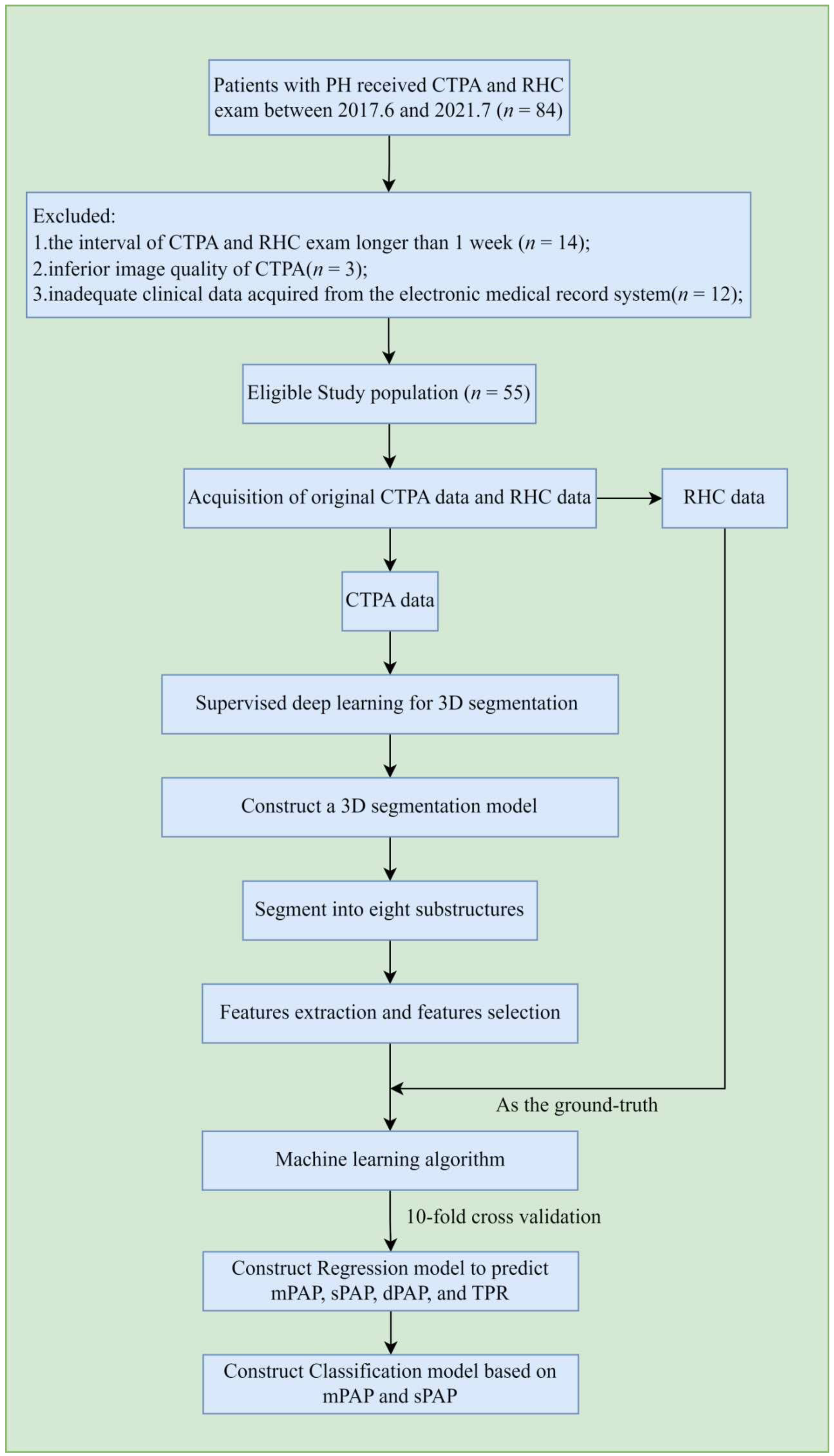
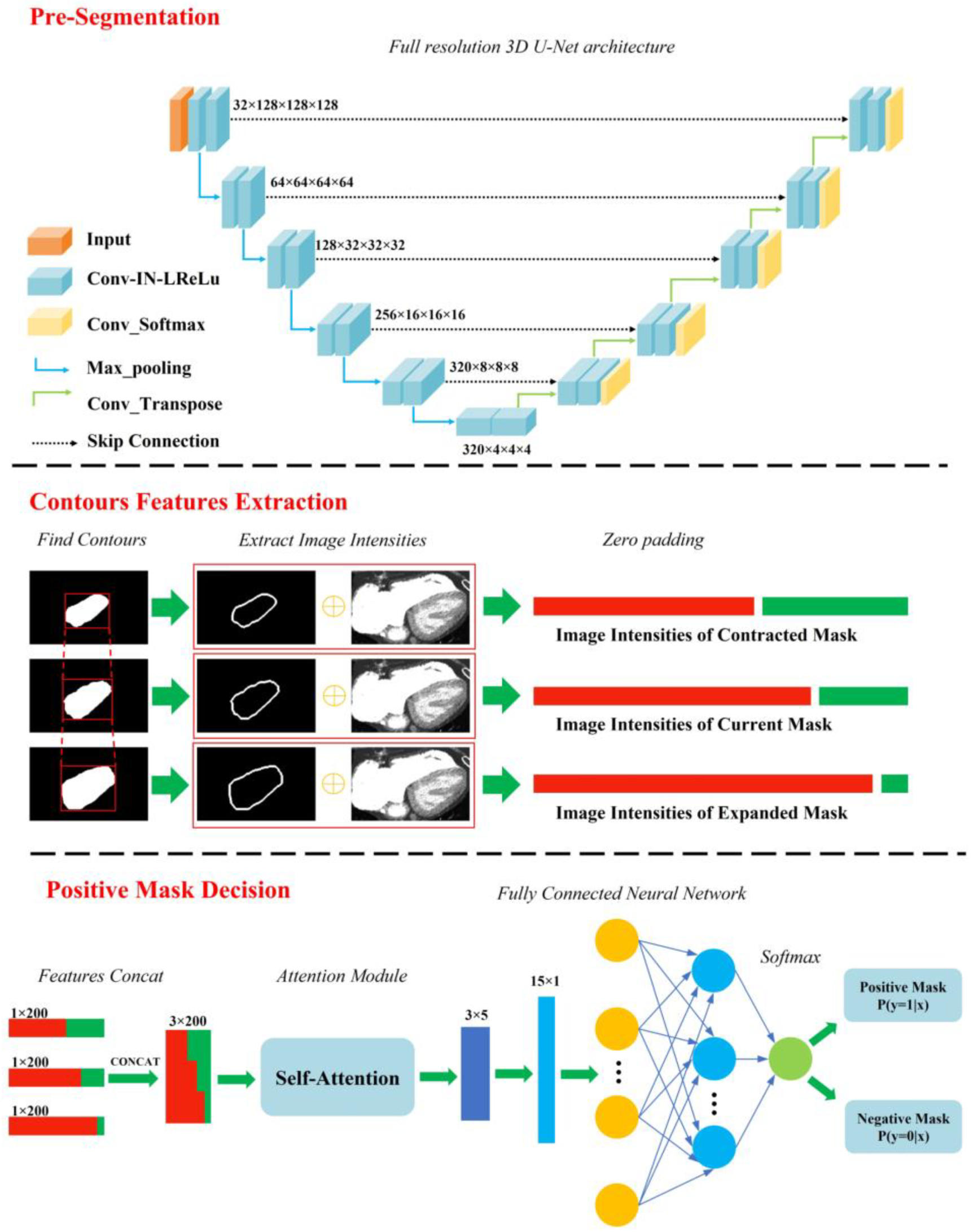

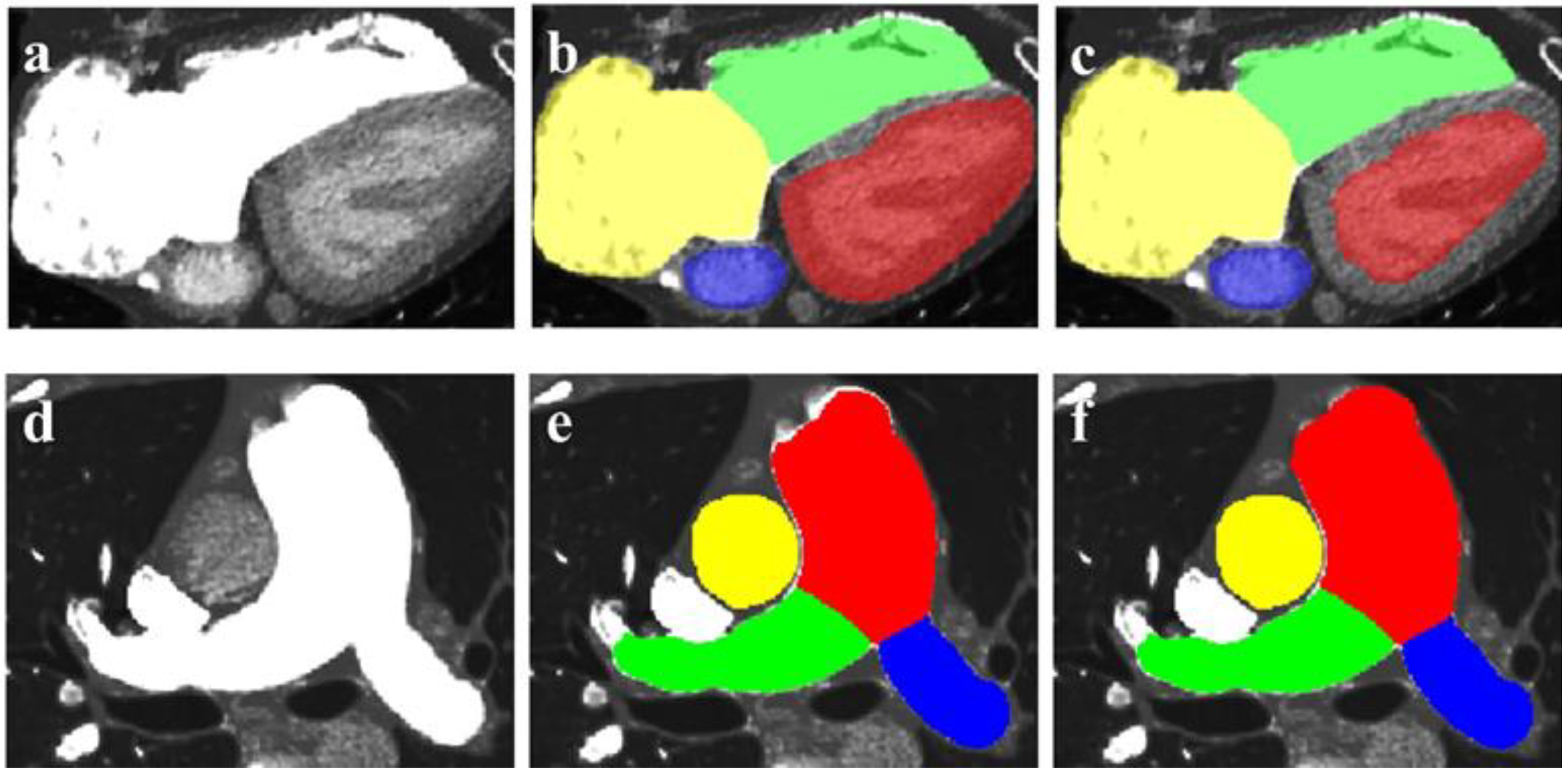
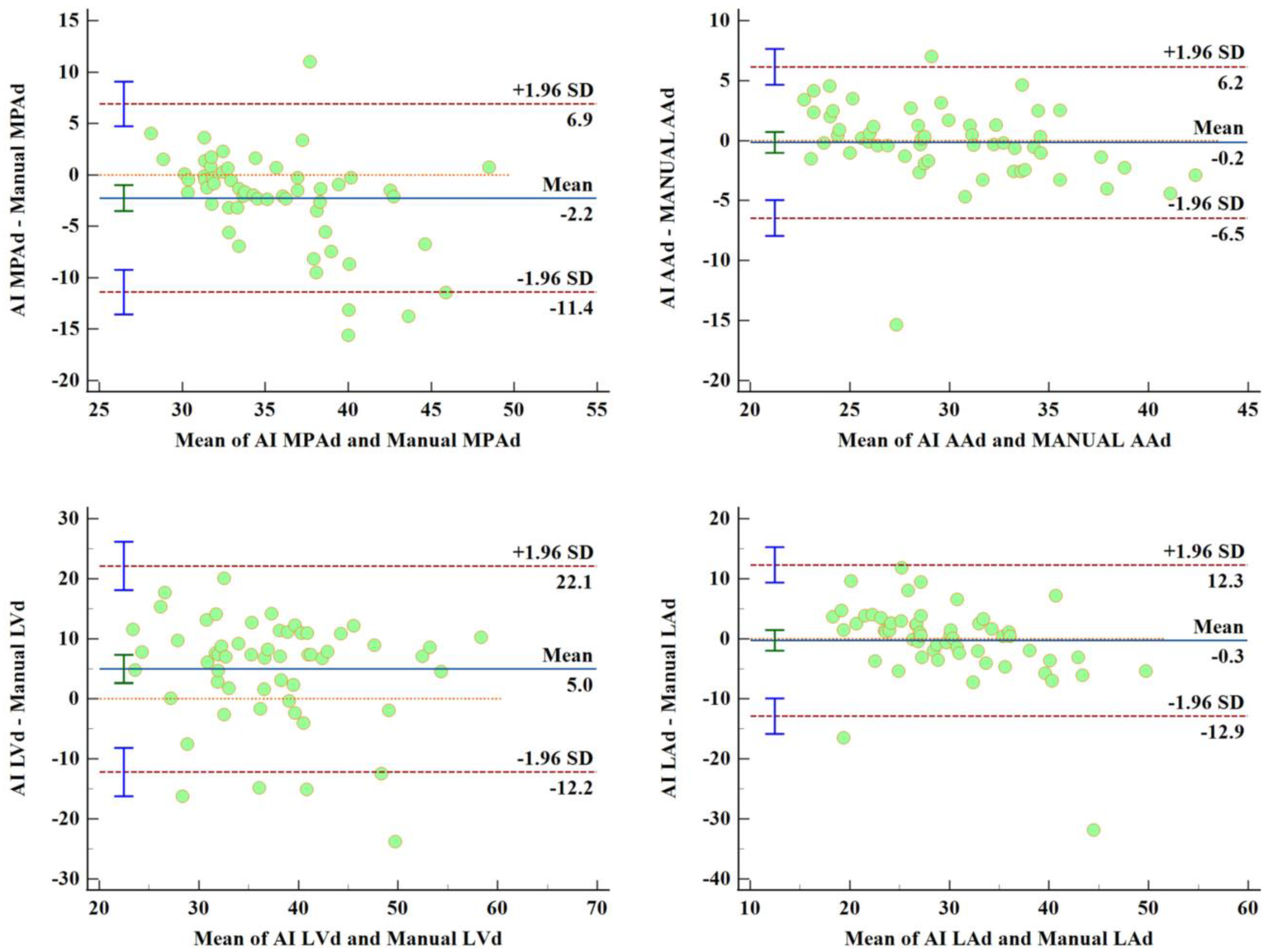
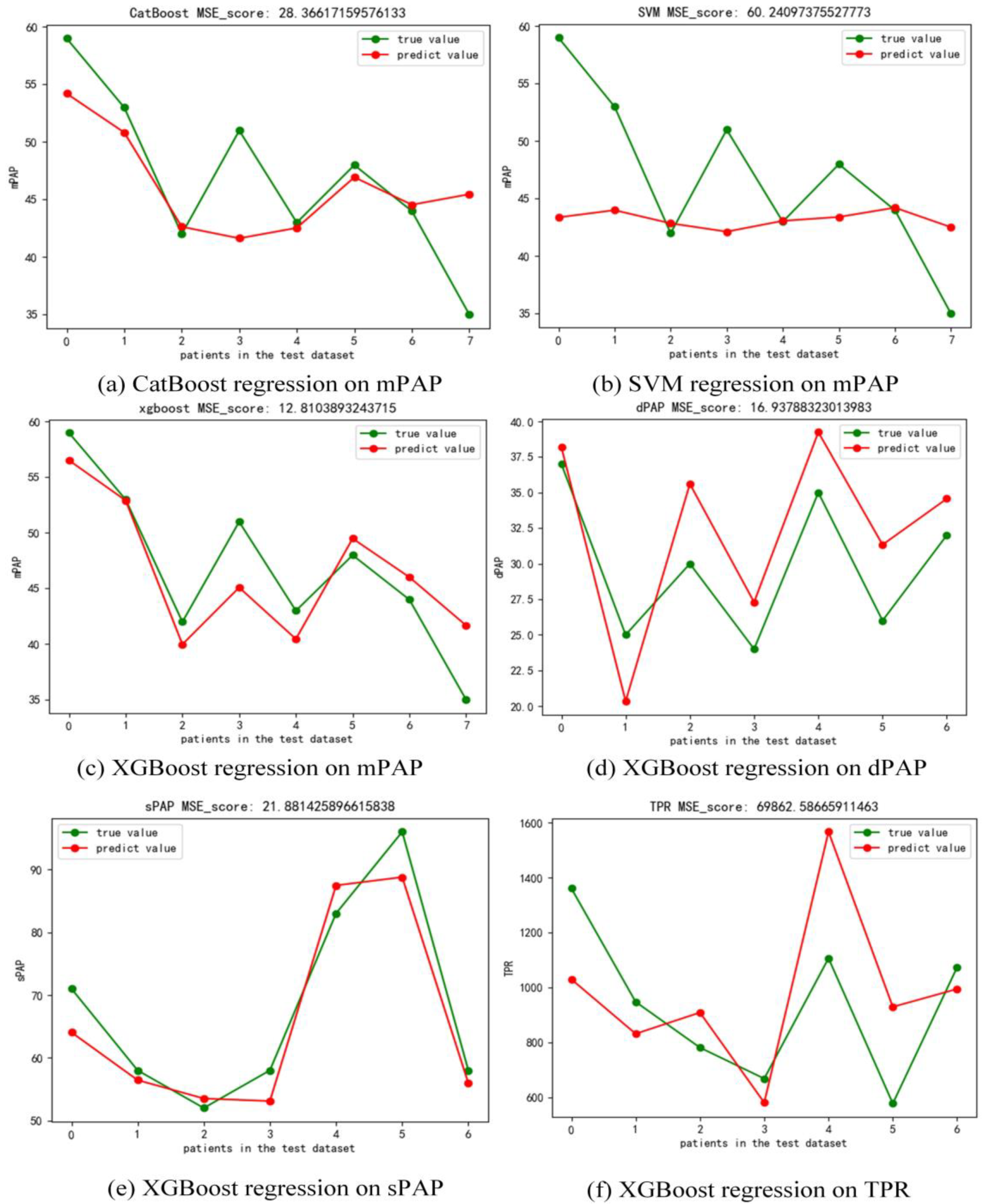
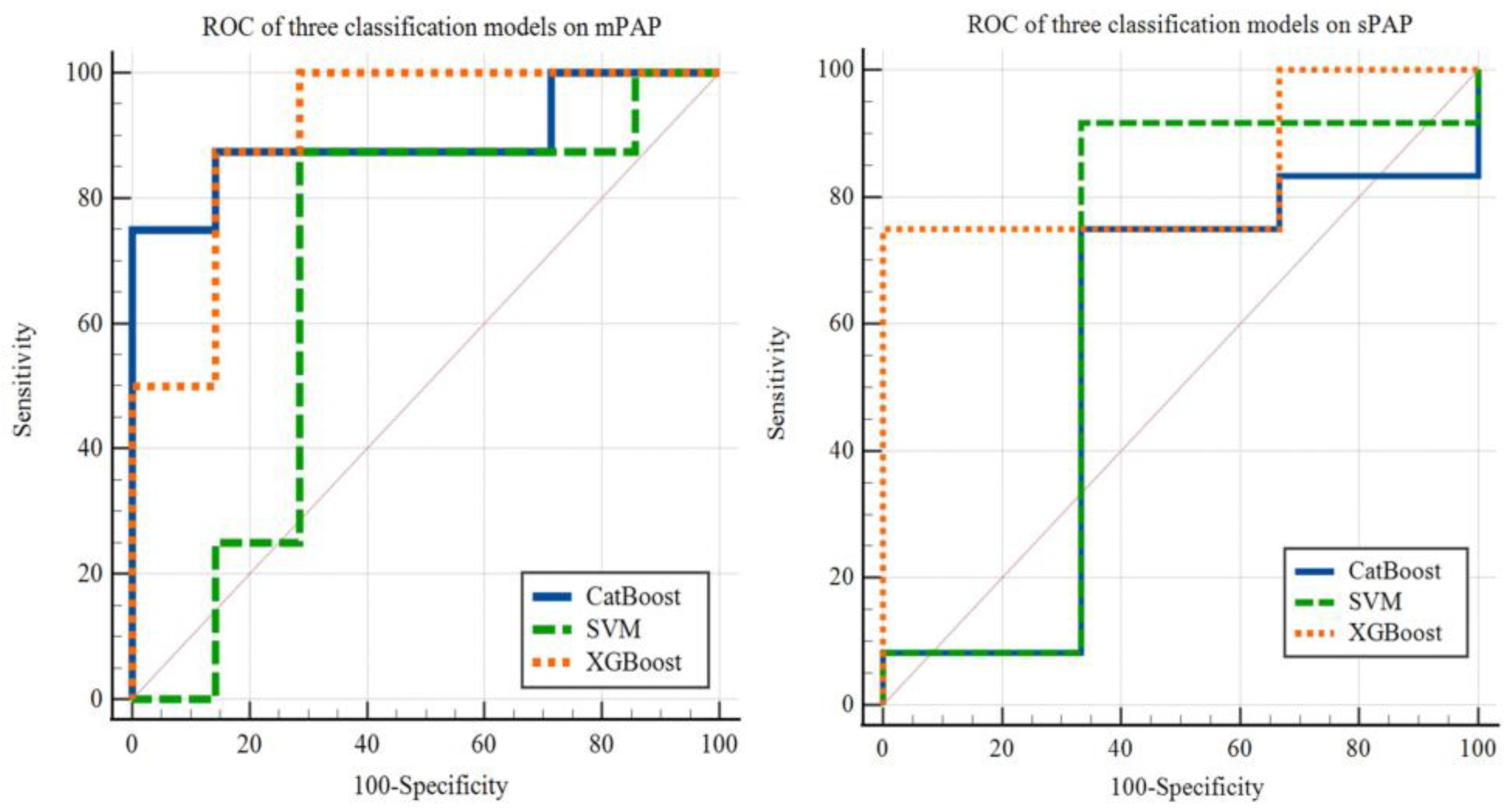
| Characteristics | Values | |
|---|---|---|
| Baseline Parameters (Mean ± SD) | ||
| Age (years) | 47.75 ± 14.87 | |
| Disease duration (years) | 3.55 ± 7.02 | |
| Gender (male/female) | 13/42 | |
| Body mass index (kg/m2) | 23.94 ± 3.87 | |
| Body surface area (m2) | 1.65 ± 0.15 | |
| BNP (pg/mL) | 289.67 ± 268.97 | |
| Clinical classification of PH (n) | ||
| I | 12 (21.8%) | |
| II | 6 (10.9%) | |
| III | 10 (18.2%) | |
| IV | 15 (27.3%) | |
| V | 12 (21.8%) | |
| Class of mPAP (n) | ||
| Mild (25–39 mm Hg) | 21 (38.2%) | |
| Severe (≥70 mm Hg) | 34 (61.8%) | |
| Class of sPAP (n) | ||
| Mild (44–55 mm Hg) | 8 (14.5%) | |
| Severe (≥55 mm Hg) | 47 (85.4%) | |
| NYHA classification (n) | ||
| I | 11 (20.0%) | |
| II | 20 (36.4%) | |
| III | 22 (40.0%) | |
| IV | 2 (3.6%) | |
| Hemodynamics (mean ± SD) | ||
| sPAP (mmHg) | 68.35 ± 20.62 | |
| dPAP (mmHg) | 35.65 ± 42.53 | |
| mPAP (mmHg) | 42.82 ± 12.74 | |
| CO (l/min) | 4.64 ± 2.54 | |
| PCWP (mmHg) | 6.86 ± 4.79 | |
| PVR (dynes.sec.mm−5) | 979.03 ± 594.73 | |
| LV | RV | LA | RA | MPA | LPA | RPA | AA | |
|---|---|---|---|---|---|---|---|---|
| nnU-Net | 82.4 ± 7.8 | 86.9 ± 6.8 | 86.9 ± 5.2 | 88.9 ± 10.3 | 91.6 ± 5.5 | 90.8 ± 2.9 | 86.4 ± 5.1 | 84.5 ± 9.0 |
| Proposed framework | 83.2 ± 7.1 | 87.0 ± 7.0 | 87.4 ± 4.7 | 90.7 ± 5.8 | 92.5 ± 3.4 | 91.3 ± 2.4 | 86.9 ± 4.6 | 86.4 ± 8.0 |
| Features | The Difference of Manual and AI Automatic Measurement | AI Automatic Measurement | Manual Measurement | |||
|---|---|---|---|---|---|---|
| Mean | Test Statistic t | 95% CI of Difference | Sig. | Mean ± SD | Mean ± SD | |
| MPAd (mm) | −2.249 | −3.573 | −3.511 to −0.9874 | 0.001 | 34.48 ± 3.98 | 36.73 ± 5.98 |
| RPAd (mm) | −0.5759 | 1.222 | −0.3693 to 1.521 | 0.227 | 24.33 ± 3.01 | 23.75 ± 3.82 |
| LPAd (mm) | 2.843 | 4.394 | 1.546 to 4.140 | 0.000 | 25.42 ± 4.61 | 22.57 ± 3.73 |
| AAd (mm) | −0.1506 | −0.347 | −1.020 to 0.718 | 0.730 | 29.81 ± 4.61 | 29.96 ± 5.57 |
| LVd (mm) | 4.975 | 4.255 | 2.632 to 7.319 | 0.000 | 39.78 ± 8.51 | 34.80 ± 9.66 |
| RVd (mm) | 0.5214 | 0.484 | −1.636 to 2.679 | 0.630 | 44.39 ± 5.62 | 43.87 ± 9.32 |
| LAd (mm) | −0.2745 | −0.320 | −1.994 to 1.445 | 0.750 | 29.60 ± 6.52 | 29.88 ± 9.06 |
| RAd (mm) | −11.68 | −7.096 | −14.98 to −8.382 | 0.000 | 46.47 ± 7.49 | 58.15 ± 15.15 |
| Mean ± SD (n = 55) | mPAP (n = 55) | sPAP (n = 54) | dPAP (n = 54) | TPR (n = 48) | |
|---|---|---|---|---|---|
| MPAd (mm) | 34.48 ± 3.98 | r = −0.107 (p = 0.435) | r = −0.185 (p = 0.180) | r = 0.011 (p = 0.938) | r = −0.115 (p = 0.435) |
| RPAd (mm) | 24.33 ± 3.01 | r = −0.149 (p = 0.277) | r = −0.115 (p = 0.410) | r = −0.065 (p = 0.640) | r = −0.250 (p = 0.087) |
| LPAd (mm) | 25.42 ± 4.61 | r = −0.120 (p = 0.381) | r = 0.050 (p = 0.721) | r = −0.156 (p = 0.261) | r = −0.170 (p = 0.249) |
| AAd (mm) | 29.81 ± 4.61 | r = −0.265 (p = 0.050) | r = −0.279 (p = 0.041) * | r = −0.183 (p = 0.186) | r = −0.156 (p = 0.289) |
| MPAd/AAd | 1.17 ± 0.17 | r = −0.212 (p = 0.121) | r = 0.175 (p = 0.216) | r = 0.208 (p = 0.131) | r = 0.091 (p = 0.539) |
| RPAd/LPAd | 0.988 ± 0.235 | r = −0.034 (p = 0.806) | r = −0.194 (p = 0.161) | r = 0.051 (p = 0.731) | r = 0.004 (p = 0.978) |
| LVd (mm) | 39.78 ± 8.51 | r = −0.208 (p = 0.123) | r = −0.348 (p = 0.009) ** | r = −0.183 (p = 0.181) | r = −0.107 (p = 0.470) |
| RVd (mm) | 44.39 ± 5.62 | r = 0.227 (p = 0.092) | r = 0.243 (p = 0.074) | r = 0.207 (p = 0.129) | r = 0.195 (p = 0.185) |
| RVd/LVd | 1.17 ± 0.34 | r = 0.302 (p = 0.023) * | r = 0.416 (p = 0.002) ** | r = 0.270 (p = 0.046) * | r = 0.259 (p = 0.075) |
| LAd (mm) | 29.60 ± 6.52 | r = −0.400 (p = 0.002) ** | r = −0.351 (p = 0.009) ** | r = −0.318 (p = 0.018) ** | r = −0.453 (p = 0.001) ** |
| RAd (mm) | 46.47 ± 7.49 | r = 0.024 (p = 0.859) | r = −0.058 (p = 0.675) | r = 0.038 (p = 0.783) | r = 0.182 (p = 0.216) |
| RAd/LAd | 1.64 ± 0.45 | r = 0.333 (p = 0.012) * | r = 0.203 (p = 0.138) | r = 0.328 (p = 0.015) * | r = 0.512 (p = 0.000) ** |
| LAa (mm2) | 1746.44 ± 621.63 | r = −0.470 (p = 0.000) ** | r = −0.445 (p = 0.001) ** | r = −0.409 (p = 0.002) ** | r = −0.494 (p = 0.000) ** |
| RAa (mm2) | 2761.05 ± 912.31 | r = 0.067 (p = 0.622) | r = −0.003 (p = 0.982) | r = −0.043 (p = 0.754) | r = 0.192 (p = 0.185) |
| LVa (mm2) | 2425.86 ± 779.36 | r = −0.155 (p = 0.254) | r = 0.267 (p = 0.049) * | r = −0.120 (p = 0.381) | r = −0.124 (p = 0.398) |
| RVa (mm2) | 3210.62 ± 830.67 | r = 0.257 (p = 0.055) | r = 0.262 (p = 0.054) | r = 0.191 (p = 0.163) | r = 0.182 (p = 0.210) |
| 95% Confidence Interval | F Test with True Value 0 | ||||
|---|---|---|---|---|---|
| Task and Method | ICC b | Lower Bound | Upper Bound | Value | Sig. |
| mPAP and CatBoost | |||||
| Single Measures | 0.525 a | −0.289 | 0.898 | 3.211 | 0.091 |
| Average Measures | 0.689 c | −0.813 | 0.946 | 3.211 | 0.091 |
| mPAP and SVM | |||||
| Single Measures | 0.074 a | −0.668 | 0.742 | 1.160 | 0.431 |
| Average Measures | 0.138 c | −4.015 | 0.852 | 1.160 | 0.431 |
| mPAP and XGBoost | |||||
| Single Measures | 0.877 a | 0.447 | 0.978 | 15.211 | 0.002 |
| Average Measures | 0.934 c | 0.617 | 0.989 | 15.211 | 0.002 |
| dPAP and XGBoost | |||||
| Single Measures | 0.824 a | 0.280 | 0.967 | 10.355 | 0.006 |
| Average Measures | 0.903 c | 0.438 | 0.983 | 10.355 | 0.006 |
| sPAP and XGBoost | |||||
| Single Measures | 0.963 a | 0.803 | 0.994 | 53.139 | 0.000 |
| Average Measures | 0.981 c | 0.890 | 0.997 | 53.139 | 0.000 |
| TPR and XGBoost | |||||
| Single Measures | 0.521 a | −0.294 | 0.897 | 3.173 | 0.093 |
| Average Measures | 0.685 c | −0.834 | 0.946 | 3.173 | 0.093 |
Disclaimer/Publisher’s Note: The statements, opinions and data contained in all publications are solely those of the individual author(s) and contributor(s) and not of MDPI and/or the editor(s). MDPI and/or the editor(s) disclaim responsibility for any injury to people or property resulting from any ideas, methods, instructions or products referred to in the content. |
© 2023 by the authors. Licensee MDPI, Basel, Switzerland. This article is an open access article distributed under the terms and conditions of the Creative Commons Attribution (CC BY) license (https://creativecommons.org/licenses/by/4.0/).
Share and Cite
Zhang, N.; Zhao, X.; Li, J.; Huang, L.; Li, H.; Feng, H.; Garcia, M.A.; Cao, Y.; Sun, Z.; Chai, S. Machine Learning Based on Computed Tomography Pulmonary Angiography in Evaluating Pulmonary Artery Pressure in Patients with Pulmonary Hypertension. J. Clin. Med. 2023, 12, 1297. https://doi.org/10.3390/jcm12041297
Zhang N, Zhao X, Li J, Huang L, Li H, Feng H, Garcia MA, Cao Y, Sun Z, Chai S. Machine Learning Based on Computed Tomography Pulmonary Angiography in Evaluating Pulmonary Artery Pressure in Patients with Pulmonary Hypertension. Journal of Clinical Medicine. 2023; 12(4):1297. https://doi.org/10.3390/jcm12041297
Chicago/Turabian StyleZhang, Nan, Xin Zhao, Jie Li, Liqun Huang, Haotian Li, Haiyu Feng, Marcos A. Garcia, Yunshan Cao, Zhonghua Sun, and Senchun Chai. 2023. "Machine Learning Based on Computed Tomography Pulmonary Angiography in Evaluating Pulmonary Artery Pressure in Patients with Pulmonary Hypertension" Journal of Clinical Medicine 12, no. 4: 1297. https://doi.org/10.3390/jcm12041297
APA StyleZhang, N., Zhao, X., Li, J., Huang, L., Li, H., Feng, H., Garcia, M. A., Cao, Y., Sun, Z., & Chai, S. (2023). Machine Learning Based on Computed Tomography Pulmonary Angiography in Evaluating Pulmonary Artery Pressure in Patients with Pulmonary Hypertension. Journal of Clinical Medicine, 12(4), 1297. https://doi.org/10.3390/jcm12041297







